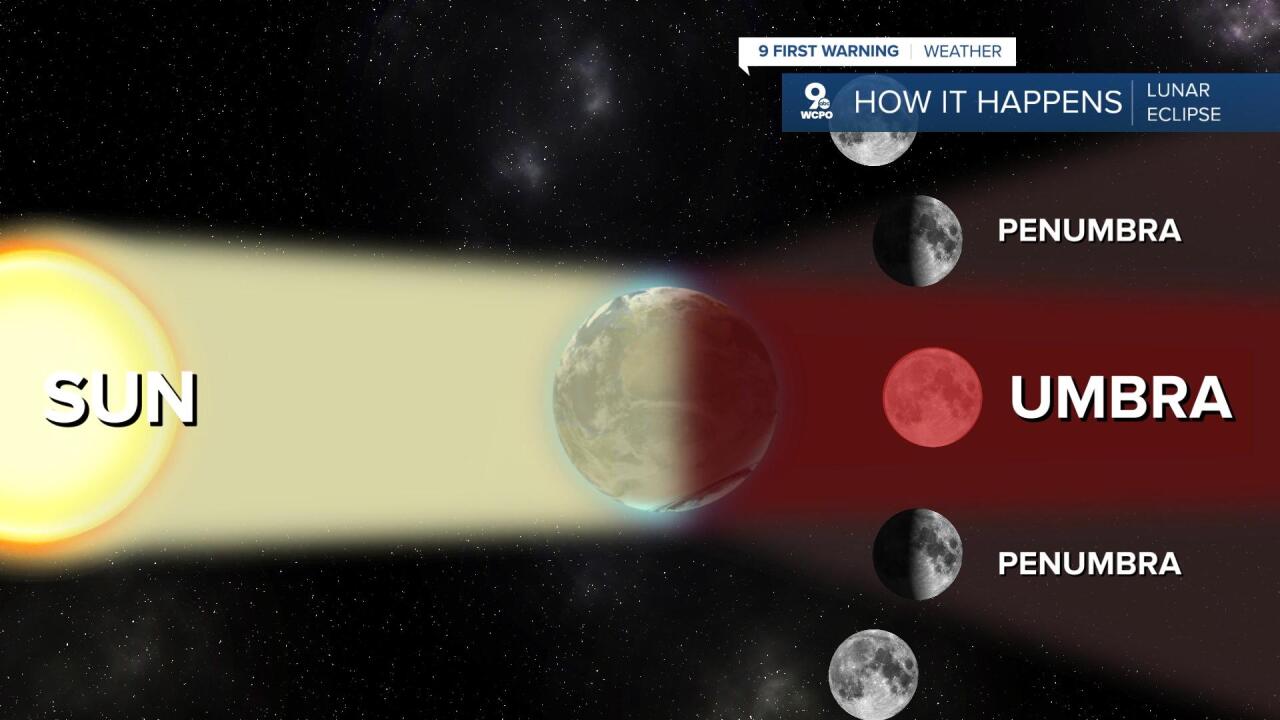CINCINNATI — This Sunday we have the chance to see a pretty cool phenomenon, a total lunar eclipse — but Mother Nature isn't likely to cooperate with us.
You may have heard this called a "blood moon" as well because it appears red in the sky. This will happen late Sunday, May 15, and overnight into early Monday, May 16.
This is the first of two lunar eclipses of 2022, but the next one won't be visible here in the Tri-State — that is set to happen Nov. 8.
This weekend's lunar eclipse will also be a "supermoon" because this is a full moon at perigee. Perigee is when the moon is closest to the earth as it makes its orbit. When a supermoon takes place, it makes the moon seem brighter and slightly larger than normal, but that is hard to determine with the naked eye.
Unlike a total solar eclipse, you can look at this without needing eye protection.

While this isn't a once-in-a-lifetime event, it is a pretty rare occurrence. The last total lunar eclipse which was visible here in the Tri-State was back on Jan. 18-19, 2019 and our next won't be until May 2025.

So you may ask, why does it appear red in the sky? This is because it is passing in the umbra, or the deep shadow of Earth, in front of the sun. Light from the sun gets refracted around the edges of the Earth's atmosphere which then falls on the moon's surface.
Timing with these events can get a little confusing. There are several different stages in this eclipse. There is the "partial eclipse" phase when the moon starts to disappear. This happens as it passes into the penumbra, a lighter shadow, of Earth. In this phase, it does not turn red. That doesn't occur until it reaches the partial eclipse stage.
The eclipse will officially start at 9:32 p.m. ET Sunday as it begins to move into the penumbra. This is when you will see the moon start to darken, or even partially disappear.
The partial eclipse stage will begin at 10:27 p.m. ET. This is when you will begin to see the red hue on the moon.
The bright red "blood moon" stage and phase will be when it hits total eclipse. That will last from 11:29 p.m. Sunday through 12:53 a.m. Monday. However, the maximum eclipse will occur at 12:11 a.m. Monday.

It then moves into partial eclipse stage again which will last until 1:55 a.m. Monday. This is when you will see the last of the redness. From there, the final part of the eclipse ends at 2:50 a.m. TimeandDay.com has a great breakdown of the timing of all of this for Cincinnati.
Unfortunately, weather-wise, Sunday's late-night weather isn't near as phenomenal as the eclipse. It looks like we will have mostly cloudy skies Sunday evening as well as some scattered showers and storms as a cold front passes through.


If you were hoping to see the eclipse, you'll probably have to travel towards the Chicago area or into Pennsylvania. If you can't make that happen and still want to watch it, NASA has set up a livestream which you can watch here.
If you do happen to catch it, don't forget to send in your photos. We would love to see them!
9 First Warning Weather 24/7 Livestream
==========
- Interactive Radar: Track weather to your doorstep
- Sign up for severe weather email alerts
- Check latest school closings and delays
- WCPO traffic updates
- Metro bus detours and updates (or call the hotline at 513-632-7538)
- Latest power outages from Duke Energy
- Flight cancellations and delays from CVG, other U.S. airports





